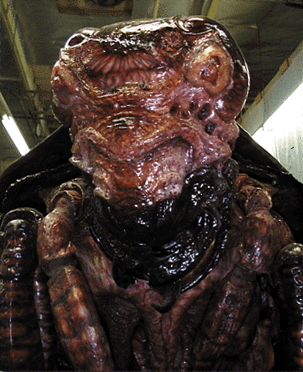The Evolution of a Movie Monster: The Judas Breed Insect from Mimic and Mimic 2
Finding copies of behind-the-scenes photos and concept art from horror and sci-fi movies can be a very difficult task. Some of the more lucrative films are extremely forthcoming in making such materials available to the public (e.g., Star Wars) but you're usually out of luck if you see something interesting in a less popular or obscure film and would love to take a closer look at it. Thankfully, the Internet is doing its part to compensate for this problem, providing search engines that can help picture hungry fans find photos of movie props and concept art in places that were not as accessible before the digital age.
For this post, I'll be looking at the evolution of the Judas Breed between Guillermo del Toro's "big bug" film Mimic (1997) and its first sequel Mimic 2 (2001). I did a post about this before when I saw some Judas Breed art posted on the deviantART site; I'm revisiting this topic using photos that I recently found online that provide a much closer look at the puppets and costumes that were used in both movies. Click below to see how a monster design changes between movies--or, to be more exact, what happens to a giant insect when it experiences budgetary downsizing.
It's common for the design of a movie monster to change between the original film and its sequels. The changes may be done to fit the new narrative or to take advantage of new special effect technologies and techniques; in other cases, the new special effects team that is hired for a sequel, prequel or spin-off would prefer to put its own stamp on a classic creature design. The Judas Breed design in Mimic 2 that was provided by Two Hours in the Dark Inc. is a simplified version of the more intricate design from the first movie, which was provided by The Character Shop (TCS), to compensate for a smaller production budget. As far as I can tell, the production crew behind Mimic 3 did not make any changes to the Mimic 2 design and just reused the costumes and props from the previous sequel to save money.
As I mentioned in my previous Judas Breed post, "While each Mimic film utilized CGI effects and life-sized puppets for the Judas Breed, the sequels also used actors in costume for tight, close-up shots. Because the sequels were produced on a much lower budget than the first film, I'm assuming that it was cheaper in some scenes to put an actor into a Judas Breed costume than to build a highly-detailed animatronic puppet. To better accommodate the actors in the suits, the Judas Breed was redesigned with a larger thorax, larger eyes, and different mandibles." As you can see in the comparison pictures below, the original Judas Breed insect has multiple mandibles, while the design from the sequels has only two moving mandibles.
Photos of the Judas Breed head from Mimic (above) and Mimic 2 (below).
(Photos provided courtesy of icollector.com, Your Props and Prop Store.)
According to TCS about its original head design, "The (Judas Breed) eyes lie further in back, and the silicone antenna nubs ... are short and resemble, in a crude way, human eyes. As in a real insect of this type, the mouth parts all move together: the labrum in and out, the minor and major mandibles scissoring, clamping, and bringing the food to the mouth, an opening and closing jaw, a tubular tongue that oscillates in and out, and 4 waving palpi to help scrape up the loose bits. ... We took artistic license with the labrum and palpi, making them end far more pointed and 'fangy' than a real insects' do. ... You can also see the silicone gill-like lungs on its chest, which had bladders underneath to make them work."
The head, upper thorax and "lungs" of the Judas Breed in Mimic.
The original Judas Breed design required up to three radio-controlled transmitters per head to make its many mandibles move. In contrast, the fewer mandibles in Mimic 2 lowered the cost of producing a Judas Breed puppet by reducing the amount of animatronic parts, even though the simplified mandible design doesn't correspond to real insect mouth parts.
For Mimic, TCS built several seven foot tall, rod- and cable-controlled Judas Breed puppets that required multiple puppeteers to operate. Mimic 2 didn't use as many puppets as the first film, but it did use an animatronic head and torso puppet that was made by FX Artist Gary Tunnicliffe.
Above and below: The head, thorax and pincers of the Judas Breed in Mimic 2.
Because Mimic 2 relied on a person in a suit for many full body shots, a complete latex and foam rubber Judas Breed costume was made for a performer to wear. The performer's two legs would then be replaced by four insectoid legs, along with a bulbous abdomen and additional wings, via CGI in post production.
Above: The full-sized Judas Breed puppets from Mimic.
Below: The Judas Breed costume from Mimic 2, complete with removable "wings".
Regardless of changes to the Judas Breed design, the Mimic films are consistent in how they used CGI to assist practical effects. How much longer this combination of techniques will continue in creature features before CGI replaces everything remains to be seen. For more in-depth information about the development of the original Judas Breed creatures, check out the Monster Legacy site.
A picture of the Judas Breed costume on set during the production of Mimic 2.





.jpg)












Comments
Post a Comment